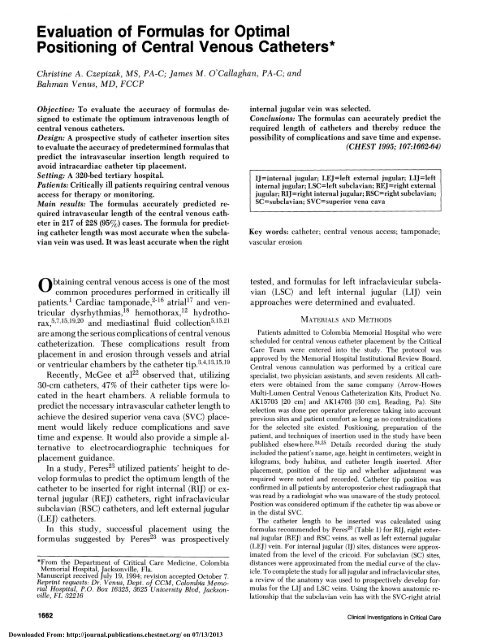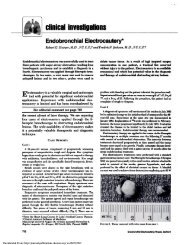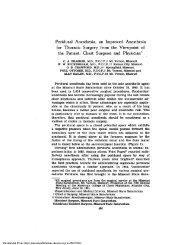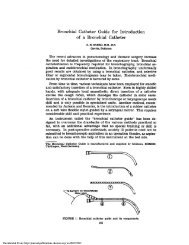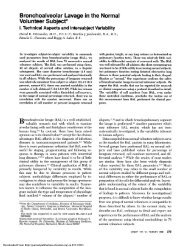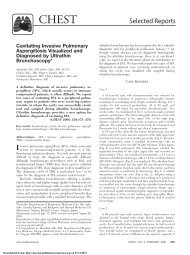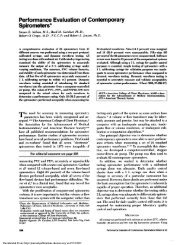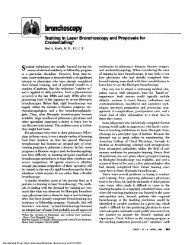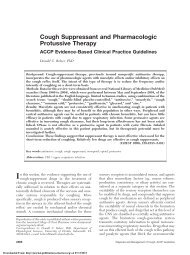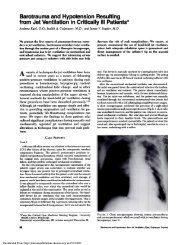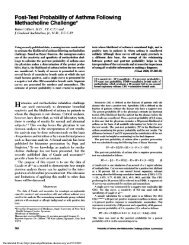Positioning of Central Venous Catheters* - Chest
Positioning of Central Venous Catheters* - Chest
Positioning of Central Venous Catheters* - Chest
Create successful ePaper yourself
Turn your PDF publications into a flip-book with our unique Google optimized e-Paper software.
Evaluation <strong>of</strong> Formulas for Optimal<br />
<strong>Positioning</strong> <strong>of</strong> <strong>Central</strong> <strong>Venous</strong> <strong>Catheters*</strong><br />
Christine A. Czepizak, MS, PA-C; James M. O'Callaghan, PA-C; and<br />
Bahman Venus, MD, FCCP<br />
Objective: To evaluate the accuracy <strong>of</strong> formulas designed<br />
to estimate the optimum intravenous length <strong>of</strong><br />
central venous catheters.<br />
Design: A prospective study <strong>of</strong> catheter insertion sites<br />
to evaluate the accuracy <strong>of</strong> predetermined formulas that<br />
predict the intravascular insertion length required to<br />
avoid intracardiac catheter tip placement.<br />
Setting: A 320-bed tertiary hospital.<br />
Patients: Critically ill patients requiring central venous<br />
access for therapy or monitoring.<br />
Main results: The formulas accurately predicted required<br />
intravascular length <strong>of</strong> the central venous catheter<br />
in 217 <strong>of</strong> 228 (95%) cases. The formula for predicting<br />
catheter length was most accurate when the subclavian<br />
vein was used. It was least accurate when the right<br />
Obtaining central venous access is one <strong>of</strong> the most<br />
common procedures performed in critically ill<br />
patients.' Cardiac tamponade,2'6 atrial'7 and ven<br />
tricular dysrhythmias,18 hemothorax,12 hydrothorax<br />
5,7,15,19,20 and mediastinal fluid collection 5,15,21<br />
are among the serious complications <strong>of</strong> central venous<br />
catheterization. These complications result from<br />
placement in and erosion through vessels and atrial<br />
or ventricular chambers by the catheter tip.3,4'13'15'19<br />
Recently, McGee et a122 observed that, utilizing<br />
30-cm catheters, 47% <strong>of</strong> their catheter tips were located<br />
in the heart chambers. A reliable formula to<br />
predict the necessary intravascular catheter length to<br />
achieve the desired superior vena cava (SVC) placement<br />
would likely reduce complications and save<br />
time and expense. It would also provide a simple alternative<br />
to electrocardiographic techniques for<br />
placement guidance.<br />
In a study, Peres23 utilized patients' height to develop<br />
formulas to predict the optimum length <strong>of</strong> the<br />
catheter to be inserted for right internal (RIJ) or external<br />
jugular (REJ) catheters, right infraclavicular<br />
subclavian (RSC) catheters, and left external jugular<br />
(LEJ) catheters.<br />
In this study, successful placement using the<br />
formulas suggested by Peres23 was prospectively<br />
*From the Department <strong>of</strong> Critical Care Medicine, Colombia<br />
Memorial Hospital, Jacksonville, Fla.<br />
Manuscript received July 19, 1994; revision accepted October 7.<br />
Reprint requests: Dr. Venus, Dept. <strong>of</strong> CCM, Colombia Memorial<br />
Hospital, P.O. Box 16325, 3625 University Blvd, Jacksonville,<br />
FL 32216<br />
1 662<br />
Downloaded From: http://journal.publications.chestnet.org/ on 07/13/2013<br />
internal jugular vein was selected.<br />
Conclusions: The formulas can accurately predict the<br />
required length <strong>of</strong> catheters and thereby reduce the<br />
possibility <strong>of</strong> complications and save time and expense.<br />
(CHEST 1995; 107:1662-64)<br />
IJ=internal jugular; LEJ=left external jugular; LIJ=left<br />
internal jugular; LSC=left subclavian; REJ=right external<br />
jugular; RIJ=right internal jugular; RSC=right subelavian;<br />
SC=subelavian; SVC=superior vena cava<br />
Key words: catheter; central venous access; tamponade;<br />
vascular erosion<br />
tested, and formulas for left infraclavicular subclavian<br />
(LSC) and left internal jugular (LIJ) vein<br />
approaches were determined and evaluated.<br />
MATERIALS AND METHODS<br />
Patients admitted to Colombia Memorial Hospital who were<br />
scheduled for central venous catheter placement by the Critical<br />
Care Team were entered into the study. The protocol was<br />
approved by the Memorial Hospital Institutional Review Board.<br />
<strong>Central</strong> venous cannulation was performed by a critical care<br />
specialist, two physician assistants, and seven residents. All catheters<br />
were obtained from the same company (Arrow-Howes<br />
Multi-Lumen <strong>Central</strong> <strong>Venous</strong> Catheterization Kits, Product No.<br />
AK15703 [20 cm] and AK14703 [30 cm], Reading, Pa). Site<br />
selection was done per operator preference taking into account<br />
previous sites and patient comfort as long as no contraindications<br />
for the selected site existed. <strong>Positioning</strong>, preparation <strong>of</strong> the<br />
patient, and techniques <strong>of</strong> insertion used in the study have been<br />
published elsewhere.24'25 Details recorded during the study<br />
included the patient's name, age, height in centimeters, weight in<br />
kilograms, body habitus, and catheter length inserted. After<br />
placement, position <strong>of</strong> the tip and whether adjustment was<br />
required were noted and recorded. Catheter tip position was<br />
confirmed in all patients by anteroposterior chest radiograph that<br />
was read by a radiologist who was unaware <strong>of</strong> the study protocol.<br />
Position was considered optimum if the catheter tip was above or<br />
in the distal SVC.<br />
The catheter length to be inserted was calculated using<br />
formulas recommended by Peres23 (Table 1) for RIJ, right external<br />
jugular (REJ) and RSC veins, as well as left external jugular<br />
(LEJ) vein. For internal jugular (IJ) sites, distances were approximated<br />
from the level <strong>of</strong> the cricoid. For subelavian (SC) sites,<br />
distances were approximated from the medial curve <strong>of</strong> the clavicle.<br />
To complete the study for all jugular and infraclavicular sites,<br />
a review <strong>of</strong> the anatomy was used to prospectively develop formulas<br />
for the LIJ and LSC veins. Using the known anatomic relationship<br />
that the subclavian vein has with the SVC-right atrial<br />
Clinical Investigations in Critical Care
Table 1-Position <strong>of</strong> the Catheter Tip<br />
Using Derived Formulas*<br />
No. <strong>of</strong> In SVC, In RA,<br />
Site Formula Cath Tips No. (%) No. (%)<br />
RSC (Hgt/10)-2 cm 76 73 (96) 3 (4)<br />
LSC (Hgt/10)+2 cm 61t 59 (97) 1(2)<br />
RIJ Hgt/10 49 44(90) 5 (10)<br />
LIJ (Hgt/10)+4 cm 44f 41 (94) 2 (5)<br />
*Cath=catheter; RA=right atrium; Hgt=height.<br />
tlncludes catheter tip in contralateral innominate vein.<br />
junction, formulas were derived for both the LIJ and LSC veins.<br />
All catheter lengths were measured from the puncture site perpendicular<br />
to the skin to the distal tip <strong>of</strong> the triple-lumen catheter.<br />
RESULTS<br />
Two hundred twenty eight patients (113 men, 115<br />
women) were entered into the study. The results <strong>of</strong><br />
the central venous catheterization using the above<br />
formulas for determining catheter length are summarized<br />
in Table 1. Average height for male and female<br />
patients and corresponding catheter lengths<br />
inserted for each site can be found in Table 2. The<br />
overall prediction accuracy for these formulas was<br />
217 <strong>of</strong> 228 (95%). The formula for predicting catheter<br />
length was most accurate for the LSC site (97%)<br />
and least accurate for the RIJ site (90%). One LSC and<br />
one LIJ catheter were placed in the innominate vein<br />
but did not require repositioning.<br />
DISCUSSION<br />
Catheter migration has been shown to occur even<br />
when central approaches are used for venous cannulation<br />
resulting in vessel or cardiac perforation and<br />
cardiac tamponade.2,6,11,12,14-16,20,26 Immediate perforation<br />
can occur from tissue puncture by guidewire,<br />
dilator, or overinsertion <strong>of</strong> a hard-tip catheter.4<br />
Catheter pressure on the vessel or cardiac wall can<br />
result in perforation within 24 h.7'26 In cases <strong>of</strong> late<br />
perforation, it is postulated that vessel or heart wall<br />
puncture occurs secondary to catheter advancement<br />
with head, arm, or trunk movement.3'4'14'20'26'27 A<br />
second mechanism for late perforation postulates that<br />
the catheter tip abutting against the vessel or heart<br />
wall causes tissue erosion that is potentiated by cardiac<br />
contraction.2'7'19'26 This is supported by results <strong>of</strong><br />
an in vitro study in which perforation rates by catheters<br />
pulsating against a simulated membrane were<br />
measured.28<br />
In a 2-year study by Ellis et al,7 vessel erosion was<br />
diagnosed in ten patients who had undergone surgery.<br />
Mean interval from time <strong>of</strong> catheter insertion<br />
to onset <strong>of</strong> symptoms was 60.2 h, making it unlikely<br />
that puncture occurred during central line placement.<br />
Nine patients recovered from complications <strong>of</strong><br />
Downloaded From: http://journal.publications.chestnet.org/ on 07/13/2013<br />
Table 2-Catheter Length Inserted in Male and<br />
Female Patients to Achieve Superior Vena Cava<br />
Catheter Tip Placement<br />
Male (n=113) Female (n=115)<br />
Average height, cm 175.2 ± 8.6* 157.7±16.5<br />
Range, cm 140-190 122-180<br />
RSC, cm 15.6±0.83 14.1±1.1<br />
LSC, cm 19.5 ±0.89 17.9±1.3<br />
RIJ, cm 17.1±1.3 15.7±0.79<br />
LIJ, cm 21.1±0.85 19.2±1.6<br />
*Mean ± standard deviation.<br />
vascular erosion. One patient died despite pericardiocentesis<br />
for cardiac tamponade.<br />
Hydrothorax has been reported in eight patients<br />
who presented with dyspnea, chest pain, pleural effusions,<br />
or mediastinal widening after central venous<br />
catheter insertion. In these cases, left-sided catheter<br />
placement was associated with a higher risk for vascular<br />
erosion.19<br />
Catheter-induced arrhythmias can present as atrial<br />
or ventricular premature beats or ventricular tachycardia<br />
or fibrillation.17"18 Catheter-induced rhythm<br />
disturbances are usually resistant to drug suppression;<br />
however, withdrawal <strong>of</strong> the catheter from the right<br />
atrial or ventricular chamber usually stops the arrhythmias.18<br />
McGee et a122 found that when a blind insertion<br />
technique was used for insertion <strong>of</strong> 20- or 30-cm<br />
catheters, 53 (47%) <strong>of</strong> 112 catheter tips were located<br />
in the atrium. Surprisingly, although the position <strong>of</strong><br />
the catheter tip was noted in the postprocedure chest<br />
radiograph in 36 patients, no attempts were made to<br />
reposition the catheters in 32 <strong>of</strong> the patients. They<br />
suggested that the operators may not be sufficiently<br />
concerned with potential complications <strong>of</strong> right atrial<br />
tip placement or may not be aware <strong>of</strong> Food and Drug<br />
Administration guidelines regarding proper catheter<br />
tip placement.<br />
Several recommendations to decrease the risk <strong>of</strong><br />
vessel or myocardial wall perforation by central<br />
venous catheter tips, including omission <strong>of</strong> beveled or<br />
hard tips,3,9,15,21 avoidance <strong>of</strong> left-sided approaches,15'20'21<br />
and immobilization <strong>of</strong> the catheter3'21 have<br />
been made. The most effective method has been to<br />
place the catheter tip in an extracardiac position<br />
within the SVC and confirming placement by chest<br />
radiograph 3,5,7,11,15,20,21,23 If repositioning is required,<br />
another chest radiograph is recommended to<br />
confirm optimum placement.21 The use <strong>of</strong> right atrial<br />
electrocardiography ensures placement <strong>of</strong> the catheter<br />
tip above the right atrium,22 but it requires a<br />
special adaptor and ECG monitor or machine and<br />
may not be readily available when catheters are<br />
placed in nonmonitored or emergency situations.<br />
From results <strong>of</strong> their study, McGee et a122 con-<br />
CHEST / 107/6/ JUNE, 1995 1663
cluded that by using a 15- or 16-cm central venous<br />
catheter, cardiac cannulation may be reduced. Our<br />
study shows, however, that the site <strong>of</strong> insertion and<br />
patient height are significant factors that influence<br />
the appropriate catheter insertion length to avoid<br />
intracardiac catheter tip position. Body habitus, eg,<br />
obesity, also may affect catheter insertion length although<br />
this was not tested in this study. When RSC<br />
or RIJ sites are used in patients that are less than 150<br />
cm in height, even a 14-cm catheter insertion length<br />
may cause atrial cannulation. Neither the formulas<br />
derived by Peres23 nor those determined in this study<br />
take into account the probable differences in catheter<br />
insertion length due to variations in same site approaches,<br />
ie, high vs cricoid IJ approaches or medial<br />
vs lateral SC approaches. Low IJ or medial SC sites<br />
are more likely to result in atrial placement.<br />
In our study, different formulas based on patient<br />
height and insertion site were prospectively derived<br />
to predict optimum central venous catheter insertion<br />
length. They were found to be 90 to 97% accurate and<br />
simple to use. It is likely that accuracy for RIJ sites<br />
could be improved by modifying the formula to<br />
height/10-1 cm. We recommend using the formulas<br />
to guide catheter placement to increase the likelihood<br />
<strong>of</strong> desired tip location within the SVC on the<br />
first attempt and eliminating the need for readjustment<br />
and confirmation chest radiograph. If time or<br />
circumstances do not permit rough measurement <strong>of</strong><br />
patient height, the average catheter insertion lengths<br />
calculated for each site may be used as guidelines for<br />
catheter placement. Follow up chest radiograph is<br />
still required to verify proper placement.<br />
ACKNOWLEDGMENTS: We thank Dr. Nikaulaus Gravenstein<br />
for his critical review <strong>of</strong> the manuscript.<br />
REFERENCES<br />
1 Food and Drug Administration. Precautions necessary with<br />
central venous catheters. FDA Drug Bull 1989; 19:15-6<br />
2 Barton BR, Hermann G, Weil R. Cardiothoracic emergencies<br />
associated with subclavian hemodialysis catheters. JAMA 1983;<br />
250:2660-62<br />
3 Brandt RL, Foley WJ, Fink GH, et al. Mechanism <strong>of</strong> perforation<br />
<strong>of</strong> the heart with production <strong>of</strong> hydro-pericardium by a<br />
venous catheter and its prevention. Am J Surg 1970; 119:311-16<br />
4 Collier PE, Ryan JJ, Diamond DL. Cardiac tamponade from<br />
central venous catheters: report <strong>of</strong> a case and review <strong>of</strong> the<br />
English literature. Angiology 1984; 35:595-600<br />
5 Dane TEB, King EG. Fatal cardiac tamponade and other mechanical<br />
complications <strong>of</strong> central venous catheters. Br J Surg<br />
1975; 62:6-10<br />
6 Eide J, Odegard E. Cardiac tamponade as a result <strong>of</strong> infusion<br />
therapy: a potentially amenable complication <strong>of</strong> central venous<br />
catheters. Acta Anaesthesiol Scand 1983; 27:181-84<br />
1664<br />
Downloaded From: http://journal.publications.chestnet.org/ on 07/13/2013<br />
7 Ellis LM, Vogel SB, Copeland EM. <strong>Central</strong> venous catheter<br />
vascular erosions: diagnosis and clinical course. Ann Surg 1989;<br />
209:475-78<br />
8 Greenall MJ, Blewitt RW, McMahon MJ. Cardiac tamponade<br />
and central venous catheters. BMJ 1975; 2:595-97<br />
9 Greenspoon JS, Masaki DI, Kurz CR. Cardiac tamponade in<br />
pregnancy during central hyperalimentation. Obstet Gynecol<br />
1989; 73:465-66<br />
10 Hansbrough JF, Narrod JA, Steigman GV. Cardiac perforation<br />
and tamponade from a malpositioned subclavian dialysis catheter.<br />
Nephron 1982; 32:363-64<br />
11 Harford FJ, Kleinsasser J. Fatal cardiac tamponade in a patient<br />
receiving total parenteral nutrition via a silastic central venous<br />
catheter. JPEN 1983; 8:443-46<br />
12 Kruass D, Schmidt GA. Cardiac tamponade and contralateral<br />
hemothorax after subclavian vein catheterization. <strong>Chest</strong> 1991;<br />
99:517-18<br />
13 Krog M, Berggren L, Brodin M, et al. Pericardial tamponade<br />
caused by central venous catheters. World J Surg 1982; 6:138-43<br />
14 Maschke SP, Rogove HJ. Cardiac tamponade associated with a<br />
multilumen central venous catheter. Crit Care Med 1984;<br />
12:611-13<br />
15 Sheep RE, Guiney WB. Fatal cardiac tamponade: occurrence<br />
with other complications after left internal jugular vein catheterization.<br />
JAMA 1982; 248:1632-35<br />
16 Van Haeften TW, van Pampus ECM, Boot H, et al. Cardiac<br />
tamponade from misplaced central venous line in pericardiophrenic<br />
vein. Arch Intern Med 1988; 148:1649-50<br />
17 Daniels SR, Hannon DW, Meyer RA, et al. A complication <strong>of</strong><br />
jugular central venous catheters in neonates. Am J Dis Child<br />
1984; 138:474-75<br />
18 Kasten GW, Owens E, Kennedy D. Ventricular tachycardia<br />
resulting from central venous catheter tip migration due to arm<br />
position changes: report <strong>of</strong> two cases. Anesthesiology 1985;<br />
62:185-87<br />
19 Duntley P, Seiver J, Korwes ML, et al. Vascular erosion by<br />
central venous catheters: clinical features and outcome. <strong>Chest</strong><br />
1992; 101:1633-38<br />
20 Iberti TJ, Katz LB, Reiner MA, et al. Hydrothorax as a late<br />
complication <strong>of</strong> central venous indwelling catheters. Surgery<br />
1983; 94:842-46<br />
21 Dailey RH. Late vascular perforations by CVP catheter tips. J<br />
Emerg Med 1988; 6:137-40<br />
22 McGee WT, Ackerman BL, Rouben LR, et al. Accurate placement<br />
<strong>of</strong> central venous catheters: a prospective, randomized<br />
multicenter trial. Crit Care Med 1993; 21:1118-23<br />
23 Peres PW. <strong>Positioning</strong> central venous catheters: a prospective<br />
survey. Anaesthesia Intensive Care 1990; 18:536-39<br />
24 McGee WT, Mallory DL. Cannulation <strong>of</strong> the internal and external<br />
jugular veins. In: Venus B, Mallory DL, eds. Problems in<br />
critical care. Philadelphia: JB Lippincott, 1988; 217-41<br />
25 Novak RA, Venus B. Clavicular approaches for central vein<br />
cannulation. In: Venus B, Mallory DL, eds. Problems in critical<br />
care. Philadelphia: JB Lippincott, 1988; 242-65<br />
26 Defalque RJ, Campbell C. Cardiac tamponade from central<br />
venous catheters. Anesthesiology 1979; 50:249-52<br />
27 Scott WL. Complications associated with central venous catheters:<br />
a survey. <strong>Chest</strong> 1988; 94:1221-24<br />
28 Gravenstein N, Blackshear RH. In vitro evaluation <strong>of</strong> relative<br />
perforating potential <strong>of</strong> central venous catheters: comparison <strong>of</strong><br />
materials, selected models, number <strong>of</strong> lumens, and angles <strong>of</strong><br />
incidence to simulated membrane. J Clin Monit 1991; 7:1-6<br />
Clinical Investigations in Critical Care


